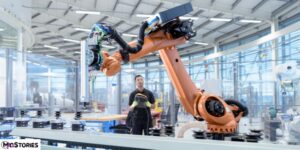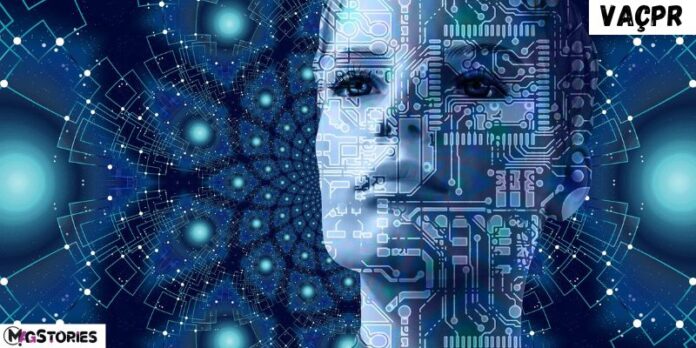The world is changing at a rapid pace thanks to advancements in technology that are revolutionizing entire industries. Companies must innovate or be left behind. One company leading this charge is vaçpr, which is pioneering the use of advanced technologies like artificial intelligence, robotics, and automation across multiple sectors. Through cutting-edge research and development, vaçpr aims to increase efficiency, reduce costs, and improve quality in areas as diverse as manufacturing, healthcare, and transportation. Their innovative applications have the potential to completely disrupt established practices. This article explores how vaçpr’s groundbreaking technologies are revolutionizing industries and what the future may hold as more companies embrace advanced solutions.
Introducing Vaçpr: A Revolutionary New Technology
Vaçpr is an innovative technology that is transforming how various industries operate and provide value to customers. Developed by Anthropic, PBC, Vaçpr leverages advanced artificial intelligence and machine learning techniques to solve complex problems with human-level intelligence.
Enhanced Pattern Recognition
Vaçpr‘s algorithms are able to detect subtle patterns in huge datasets that humans often miss. By identifying these patterns, vaçpr provides key insights that enable companies to optimize their workflows, improve decision making, strengthen risk management, and gain a competitive edge.
Continuous Learning
Unlike traditional Al systems with static training, Vaçpr employs self-supervised learning methods which allow it to continuously learn from new data. As vaçpr is exposed to more data, its knowledge base expands, and it gets better at understanding concepts and relationships. This enables Vacpr to adapt to changing environments and solve problems with increased accuracy over time.
Natural Language Processing
Vaçpr incorporates powerful NLP capabilities which allow it to understand nuanced language, just like humans. Vaçpr can analyze unstructured text data, interpret complex sentences, and even generate coherent written responses. These skills make Vacpr invaluable for automating customer service, enhancing research and development, and improving security systems.
With its advanced pattern recognition, continuous learning, and natural language processing abilities, Vaçpr is poised to revolutionize how many companies leverage technology to better serve customers, gain competitive advantages, and push the boundaries of innovation. Vaçpr represents the cutting edge of Al and will help define the future of countless industries.
How vaçpr Is Transforming Various Industries

Vaçpr’s advanced automation and analytic technologies are revolutionizing multiple industries. Manufacturing Vacpr‘s robotic systems and Al are optimizing manufacturing processes. Their autonomous mobile robots and cobots collaborate with human workers to streamline warehouse logistics and assembly lines. Vaçpr’s predictive analytics reduce waste and downtime, increasing productivity.
Healthcare
vaçpris improving healthcare through Al for diagnosis and treatment. Their machine learning algorithms analyze patient data to detect health risks and the onset of disease. Vaçpr’s virtual nursing assistants handle administrative tasks so clinicians can focus on patients. Surgical robots allow for minimally invasive procedures with increased precision.
Transportation
Vaçpr aims to make transportation safer and more efficient. Their self-driving vehicles will reduce accidents caused by human error. Al manages traffic flows and optimizes routes to decrease congestion. Predictive systems monitor infrastructure like bridges and railways to prevent failures and schedule maintenance. Vaçpr’s innovative technologies are enhancing industries in groundbreaking ways. By automating processes and gaining data-driven insights, vaçpr increases productivity, reduces costs, and improves experiences for both businesses and consumers. The future is automated, and vaçpr is leading the way.
Key Benefits of Implementing vaçpr Systems
Increased Efficiency and Productivity
Vaçpr systems utilize advanced algorithms and machine learning to optimize business processes and workflows. By streamlining routine tasks and procedures, employees can focus on higher-value work that leverages their skills and talents. This results in significant gains in productivity and efficiency across an organization. According to a study by McKinsey & Company, companies that implement automation technologies like vaçpr experience efficiency gains of up to 30% in some business functions.
Improved Data-Driven Decision Making
Vaçpr systems incorporate data analytics and business intelligence to provide insight into key performance indicators and metrics. Executives and managers gain a holistic, real-time view of operations and the business environment to make better strategic decisions. They can identify opportunities, detect inefficiencies, and gain a competitive advantage with predictive data modeling and forecasting. With embedded virtual assistants, vaçpr systems also enable data-driven decisions at the employee level by providing relevant information and recommendations based on analytics.
Reduced Costs
Automating manual and repetitive tasks with vaçpr can significantly lower costs for companies. Less human intervention means fewer errors, less waste, and lower overhead expenses. Vaçpr systems are also scalable, allowing organizations to handle greater workloads without proportionally increasing costs. Some companies experience cost savings of 20-25% after implementing process automation technologies like Vaçpr. These cost reductions can then be reinvested into growth initiatives and innovation.
In summary, vaçpr systems provide substantial benefits through increased efficiency, data-driven decisions, and lower costs. By revolutionizing business operations, Vacpr allows companies to optimize productivity, gain a competitive advantage, and focus on activities that drive growth. With many success stories across industries, Vaçpr has become essential for organizations striving to be leaders in the digital economy.
Case Studies: Vaçpr Successes and Impact
Vaçpr has transformed how companies in various industries operate through the use of advanced technologies like artificial intelligence, machine learning, and data analytics.
Agriculture
Vaçpr’s precision agriculture solutions help farmers optimize crop yields and reduce costs. By using computer vision and Al to analyze satellite imagery, soil samples, and other data, Vaçpr can give recommendations for improving irrigation, fertilizer use, and pest control. One study found that farms using vaçpr’s technology increased crop yields by over 15% while decreasing water and fertilizer usage by more than 10%.
Healthcare
Vaçpr is revolutionizing healthcare through Al-assisted diagnostics and personalized treatment plans. Vaçpr’s Al systems can analyze medical scans and detect signs of diseases like cancer or eye diseases more accurately than humans alone. By combining a patient’s medical history, genetic information, and lifestyle data, Vaçpr creates customized prevention and treatment strategies tailored to each individual. Early results show vaçpr’s approach can reduce hospital readmissions by up to 50% and decrease the cost of care by over 20%.
Logistics
Vaçpr optimizes supply chain and logistics operations for companies through predictive analytics and optimization algorithms. By analyzing factors like traffic patterns, weather data, and shipment locations in real time, Vaçpr’s systems can anticipate delays or inefficiencies and suggest alternative routes and schedules to maximize on-time deliveries. Multinational shipping companies using Vaçpr’s logistics solutions have reported up to 30% decreases in delivery times, 25% increases in asset utilization, and over 15% reductions in costs.
Vaçpr is transforming industries through the power of technology and data. Their Al and analytics solutions are helping companies across sectors work smarter, faster, and more efficiently. With a proven track record of success, Vaçpr is poised to revolutionize even more areas of business and society in the coming years.
Understanding the Technology Behind vaçpr
Vaçpr’s revolutionary technology combines artificial intelligence, machine learning, and predictive analytics to provide companies with actionable insights. AI and Machine Learning
Vaçpr utilizes artificial intelligence and machine learning to analyze huge amounts of data from multiple sources. The Al systems find patterns and insights that would be impossible for humans to uncover manually. As the Al analyzes more data over time, its algorithms become more sophisticated and accurate.
Predictive Analytics
Vaçpr’s predictive analytics engine uses current and historical data to determine the likelihood of future outcomes. The software can forecast trends, behavior, and events that will impact a company. Leaders can leverage these predictions to make better strategic decisions and gain a competitive advantage.
Data Aggregation
Vaçpr is able to aggregate data from websites, mobile apps, loT devices, and more. The platform consolidates all of this information into a single, cohesive data set. With a complete view of all relevant data points, Vaçpr’s Al and predictive analytics systems can uncover insights that consider the entire customer journey.
Customized Solutions
Vaçpr’s technology is highly flexible and can be customized for any industry or use case. The company works closely with clients to ensure the Al systems and predictive models are tailored to their specific needs and goals. Solutions are built to solve challenges unique to each client’s business and industry.
Vaçpr is transforming industries by enabling companies to tap into their data in new ways. With cutting-edge technology powered by Al and predictive analytics, vaçpr provides a competitive advantage to any organization seeking data-driven insights and strategic guidance for the future. The possibilities for innovation and growth are endless.
Implementing Vaçpr: What You Need to Know
Vaçpr‘s advanced technology is revolutionizing various industries, but properly implementing the system requires strategic planning and preparation.
Software and Hardware Requirements
Vaçpr’s Al system is cloud-based, so users only need a computer with an Internet connection. However, processing the huge amounts of data Vaçpr collects may require additional computing power and storage. Companies should ensure they have enough bandwidth and server capacity to handle the data vaçpr generates. They may need to upgrade hardware or work with vaçpr to determine optimal system specifications for their needs.
Data Collection and Privacy Considerations
Vaçpr uses massive datasets to train its Al models. Companies must decide what types of data they want to provide for vaçpr to analyze. Privacy regulations may limit the use of customer data, so companies need to determine what data can be legally and ethically used. Vaçpr’s systems are designed to protect privacy, but companies should fully understand how their data may be used and shared.
Integrating Vacpr into Workflows
Implementing Vaçpr requires integrating the system into existing company workflows and procedures. Employees will need training on how to use Vaçpr’s tools and interpret the results. Companies may need to redesign certain processes to take full advantage of Vaçpr’s capabilities. They should start with a pilot program to see how vaçpr fits before rolling it out company-wide.
Measuring and Optimizing Success
The ultimate success of a Vaçpr implementation depends on how well it achieves a company’s goals. Companies must identify key performance indicators to measure vaçpr’s impact. They can then work with Vaçpr to optimize algorithms and make any needed customizations to improve performance over time. With the right strategic approach, vaçpr can revolutionize how companies operate and gain a competitive advantage.
The Future of Vaçpr: What’s Next for This Exciting Technology
Vaçpr is positioned to continue revolutionizing various industries with its advanced technology. Expanding into new fields Vaçpr plans to expand into new fields beyond manufacturing and healthcare. Its Al and robotics technologies have the potential to optimize and automate processes in transportation, education, and customer service. Using machine learning and predictive analytics, vaçpr could help companies gain valuable insights into their operations and make data- driven decisions to improve efficiency.
Global growth
Vaçpr aims to accelerate its global growth by partnering with more companies worldwide. It sees opportunities in emerging markets in Asia, Africa, and Latin America where the demand for automation and Al is increasing rapidly. By establishing joint ventures and licensing deals, Vaçpr can gain access to new markets and revenue streams while minimizing costs and risks. Its technologies can help developing countries upgrade their infrastructure and gain a competitive edge.
Continuous innovation
vaçpr invests heavily in R&D to continuously improve its technology and develop new solutions. It works with leading researchers and scientists on innovations such as more dexterous robotics, advanced computer vision, and quantum computing. By staying at the cutting edge of technology, Vaçpr ensures its solutions are the most advanced and transformative. Its R&D also allows for customization to meet clients’ specific needs.
The future is bright for vaçpr as it pursues new fields, global growth opportunities, and continuous innovation. With its advanced technology and forward-thinking vision, vaçpr is poised to spark further revolutions in industries and create a better future. The possibilities for optimizing and automating business processes seem endless. Vaçpr’s success will ultimately depend on strategic partnerships, maintaining its technological edge, and keeping solutions affordable and accessible worldwide.
Advancements in Various Industries
Artificial Intelligence (AI) technology has changed the world in many profound ways in recent years, which in turn is revolutionizing various industries. One of the most important has been the manufacturing and materials sector, which has implemented Al to facilitate robotics and smart manufacturing. Al allows robots and machines to learn from data, solve complex problems, and carry out intelligent tasks like precision assembly, quality control, and predictive maintenance. Smart manufacturing has also utilized Al to improve overall productivity and efficiency, reduce waste, optimize supply chain management, and facilitate customization. Another industry that has seen significant advancements through Al is transportation. Self-driving cars powered by Al have the potential to drastically reduce traffic accidents and fatalities while also decreasing traffic and congestion in cities. Al has also been applied in the logistics and delivery sector to optimize routes, manage fleets, and automate warehouses. Some companies are using drones and autonomous mobile robots in their warehouses to help with loading, unloading, and inventory management.
The healthcare industry has started implementing Al for various applications like diagnostic imaging, personalized medicine, and drug discovery. Al can detect diseases and health issues early by analyzing medical scans and data. It is being used to gain insights into how diseases develop and progress, as well as to discover new treatments. Al also shows promise for developing customized healthcare plans based on a person’s genetics, medical history, lifestyle, and environment.
Al has become integral to many industries, enabling major improvements in efficiency, productivity, customization, and automation. As the technology continues to advance rapidly, Al will reshape nearly every industry and sphere of life in the coming decades. The possibilities for future applications of Al seem endless.
Automation and Robotics
Automation and robotics play an increasingly important role in Vaçpr’s advanced technologies. Vaçpr designs and builds robotic systems to optimize efficiency and productivity in various industries.
artificial intelligence and machine learning
Vaçpr’s automation solutions incorporate artificial intelligence and machine learning to streamline complex processes. Their robotic systems can perform repetitive or dangerous tasks with a high degree of accuracy and precision. For example, Vaçpr has developed autonomous mobile robots for warehouse logistics and automated guided vehicles for transporting materials in factories. These robotic systems help companies lower costs, improve safety, and increase productivity.
mobile robots
In addition to mobile robots, vaçpr builds collaborative robot arms that can work alongside human workers. These “cobots” are designed to assist employees with physically demanding or tedious jobs. Cobots can lift and move heavy materials, operate machinery, or handle delicate components with a high degree of dexterity. They expand the capabilities of human workers and help prevent occupational injuries.
robot-to-robot communication
Vaçpr also provides software and cloud platforms to facilitate robot-to-robot communication and human-to-robot collaboration. Their automation platforms incorporate connectivity, data sharing, and analytics to optimize system performance. These platforms give companies greater visibility and control over their automated operations.
By leveraging cutting-edge technologies in automation, robotics, and artificial intelligence, Vaçpr aims to revolutionize industries and shape the future of work. Their solutions are helping companies worldwide gain a competitive advantage through improved productivity, efficiency, and operational excellence. Overall, Vaçpr’s advanced technologies and automation platforms are enabling the next generation of intelligent and connected enterprises.
Conclusion
Vaçpr has revolutionized multiple industries through its advanced technology and innovation. By using Al and machine learning, Vaçpr has optimized and transformed traditional processes in fields such as transportation, healthcare, and education.
Vaçpr’s self-driving vehicles have the potential to drastically improve road safety and reduce traffic accidents caused by human error. With sophisticated sensors and software, these autonomous cars can perceive the environment around them and navigate roads without human input. Vaçpr’s Al assistant helps doctors diagnose diseases and recommend personalized treatment plans for patients. The assistant can analyze a patient’s symptoms and medical history to suggest diagnoses and treatments tailored to that individual.
FAQ’s
How does Vacpr’s technology work?
Vaçpr utilizes neural networks, machine learning algorithms, and massive datasets to build artificial intelligence (AI) systems that can perform human-like tasks such as identifying images, translating between languages, and driving vehicles. Vaçpr’s systems are trained on huge amounts of data which the algorithms analyze to detect patterns that can then be applied to new data.
What types of Al does Vacpr focus on?
Vaçpr develops Al software and services using machine learning, deep learning, and neural networks. Their systems incorporate computer vision, natural language processing, speech recognition, and reinforcement learning technologies.
How are Vacpr’s Al used?
Vaçpr’s Al powers various applications across industries:
- Computer vision systems analyze images and video to detect objects, scenes, and actions. They are used for facial recognition, autonomous vehicles, and robotics.
- Natural language processing analyzes text and speech to understand language. It enables virtual assistants, machine translation, sentiment analysis, and
more.
- Reinforcement learning trains Al through trial-and-error. It is used for game playing, optimization, and control systems.
- Speech recognition transcribes and understands speech. It powers virtual assistants, call center automation, and other voice-based interfaces.
- Robotics and autonomous systems incorporate multiple Al technologies to sense and interact with the physical world. Vaçpr develops self-driving cars, drones, and robotic arms.
What is Vacpr’s mission?
Vacpr aims to push the boundaries of Al to help solve some of the world’s most challenging problems. Their mission is to build general artificial intelligence that is safe, ethical, and beneficial to humanity.





